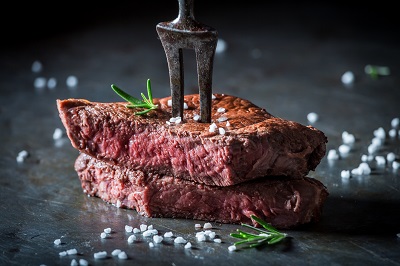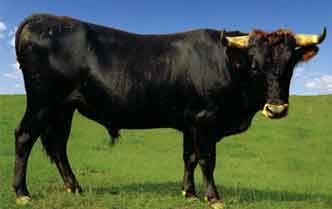Salting Steak: Why (And How To) Use Kosher Sea Salt When Cooking Steak
Do your steaks always turn out dry? You need to tenderize steaks with kosher sea salt. Here's your salting steak guide, why and how to use sea salt.
When you picture the perfect steak you probably think of two things: a crispy, crunchy, savory outer crust and a juicy, red, tender interior. If you've been wowed by professional chefs at a steakhouse and wondered how they get that perfect cook every time, we're here to tell you: The secret is salt.
Of course, there is much more involved, but salting steak is the first and most important step in cooking a perfectly seared steak. We'll tell you why below.

The Science of Salting Steak
Salt has been used in culinary pursuits essentially since the dawn of man, though its use was much less glamorous then than it is now. The first recorded use of salt goes back to China around 2700 B.C. Salt back then was mostly used as a preservative.
People in civilizations around the globe learned that by packing perishable foods with salt, they would last much longer than thought possible. This allowed fisherman to bring fish in from the coasts or travel long distances in trade.
Today, salt is used in cooking (especially with meat) to do two things: tenderize and boost flavor.
How Salt Tenderizes
Salt tenderizes a hunk of meat, or the stalk of fibrous vegetables, in the same way it preserves them. Adding salt to the exterior of a piece of steak draws out the moisture in the steak. The salt then dissolves in this moisture, creating a brine that is then re-absorbed back into the steak.
In this process, the lean muscle proteins in the meat are broken down, made juicier and more tender. All thanks to salt!
How Salt Adds Flavor
Of course, tenderizing meat with salt and making it juicier will increase its flavor, but salt makes things taste better for reasons that have nothing to do with the food itself. Salt also a complementary relationship with our tongues.
Saltiness is actually one of the five basic "flavors" our tongues can taste, along with bitterness, sweetness, sourness, and umami (or, the savoriness you get from something like gravy). What makes salt different from these other flavors is that they can overpower or complement them, "opening up" our taste buds.
Salt has been shown to reduce the bitterness of other foods, improving and altering their taste. For example, many people find dark chocolate too bitter to eat. But adding salt to a chocolate bar suppresses this bitterness and allows the other complex flavors of the chocolate to shine.
Adding salt to sweet or sour things won't necessarily reduce their flavors, but will balance them out, making the food less one dimensional.
The Maillard Reaction
Every steak worth its salt has to have a flavorful, crispy sear. And salt plays a pivotal role in allowing this to happen. To understand why, we first have to understand the Maillard Reaction.
The Maillard Reaction is what the chemical process that leads to the burning, or "browning" of food. This process unlocks new flavors and textures in our food. This is why a seared steak is much more flavorful than a steak that is simply boiled.
For the Maillard Reaction to occur, you need two things: heat (a lot of it) and dryness. Salt aids in the latter part by, as we mentioned, drawing moisture out of the steak. Though much of the moisture is reabsorbed, the exterior portion of the steak remains drier than it was before.
This moisture elimination allows the steak to brown faster when introduced to a smoking hot skillet, reducing the chance of overcooking it.
How (and When) to Salt a Steak
So now that we know why we should salt a steak, we'll explain how and when to do the salting. As for the how, the process is very simple. All you have to do is toss salt on every side of the steak, about a tablespoon for each side. Then, you just leave the steak uncovered on a counter or in the refrigerator.
When you should do this before cooking is, however, is up for debate. Some people will tell you should salt your meat right before throwing it in the pan. Others will say you should salt the pan first, and some might say you shouldn't salt the meat at all!
But the folks over at the Food Lab have figured out the best thing to do is salt your meat a full 24 hours before cooking. This allows your the salt to do its briny magic on your prime cut of meat.
If you don't have that kind of time to spare, you should wait at least 40 minutes after salting before cooking your meat. If you don't even have that kind of time to spare, your best route is to just salt the meat directly before cooking.
The logic here is that 40 minutes gives your meat the time to reabsorb its liquid and any amount of time before that just makes your steak wetter. But salting it right before putting it in the pan will aid in forming a solid crust on the steak.
So if you're going to salt your steak for the full 24 hours, just salt it on a wire rack and place it uncovered in the fridge. If you're going to salt it for 40 minutes, you can just leave it on the counter.
Let's Get Cooking!
To sum things up for you, salt tenderizes meat, adds flavor thanks to various chemical processes. To get the most out of your salt, you should consider salting steak a full 24 hours before cooking.
We hope, with this information in tow, you'll be able to cook a juicy, perfectly seared steak for your next date night or family gathering. Of course, salting steak is only half the battle.
You still need good quality meat. If you're unhappy with your grocery store's offerings, you should check out our steak offerings.








